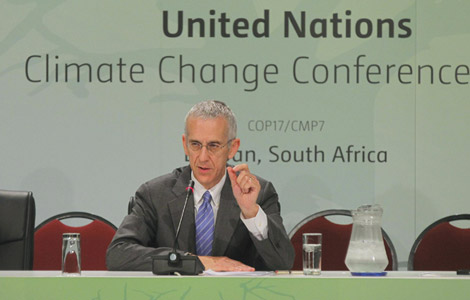China's efforts to combat climate change
Updated: 2011-11-22 15:55
(Xinhua)
|
|||||||||||
BEIJING - China aims to reduce the per-unit GDP greenhouse gas emission in 2020 by 40 percent to 45 percent as compared to that of 2005. To accomplish the goals, China adopted a range of major policy measures to mitigate and adapt to climate change during the 11th Five-Year Plan (2006-2010) period, and has achieved remarkable results. Following are the major achievements China made during this period:
Closure of outdated industrial capacity
China shut down small thermal power generating units with a total generating capacity of 76.82 million kw, and eliminated backward steel production capacity to the tune of 72 million tons.
China phased out 120 million tons of iron production capacity, 370 million tons of cement production capacity, 107 million tons of coke production capacity, 11.3 million tons of paper production capacity, and 45 million cases of glass production capacity.
From 2005 to 2010, coal consumption in thermal power supply dropped 10 percent from 370 g/kwh to 333 g/kwh.
Strategic and newly emerging industries
The government has established 20 venture capital investment funds and supported the growth of innovative enterprises in energy conservation, environmental protection, new energy development and other sectors in strategic new industries.
In 2010, the output value of China's high-tech manufacturing industries reached 7.6 trillion yuan ($118.75 billion), ranking the second in the world, and more than twice the figure for 2005.
Service industry
From 2005 to 2010, the added value of China's service sector increased 11.9 percent per year on average, 0.7 percentage point higher than that of GDP, and with its proportion in GDP rising from 40.3 percent to 43 percent.
Energy-saving technology and products
By the end of 2010, the implementation rate of mandatory energy efficiency standards for new urban buildings reached 99.5 percent in the design stage and 95.4 percent in the construction stage.
During the 11th Five-Year Plan period, the accumulated total energy-efficient floor space constructed was 4.86 billion square meters, with energy-saving capacity of 46 million tons of standard coal.
The government has taken energy conservation actions in the retail sector by restraining the production, marketing and use of plastic shopping bags, and curbing over-packaging.
The central treasury has appropriated subsidies to support the production of and promote the use of some 360 million high-efficiency illumination products, 30 million high-efficiency air conditioners and one million energy-efficient motor vehicles, which have realized an annual energy-saving capacity of 20 billion kwh.
The market share of high-efficiency illumination products reached 67 percent, and that of high-efficiency air-conditioners, 70 percent.
Hot Topics
HIV/AIDS, Egypt protest, Thanksgiving, climate change, global economic recovery, home prices, high-speed railways, school bus safety, Libya situation, Weekly photos
Editor's Picks

|

|

|

|

|

|







